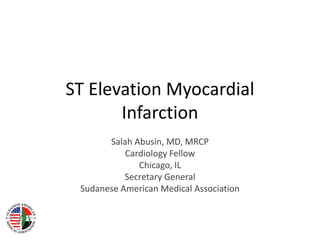
St elevation myocardial infarction
- 1. ST Elevation Myocardial Infarction Salah Abusin, MD, MRCP Cardiology Fellow Chicago, IL Secretary General Sudanese American Medical Association
- 2. Outline • Definition • STEMI – Definition – H&P DD – ECG DD • Reperfusion therapy – Fibrinolysis – Primary PCI
- 3. Acute Coronary Syndromes • Refers to any constellation of clinical symptoms that are compatible with acute myocardial ischemia
- 4. ACS Spectrum AHA.ACC 2004 STEMI guidelines
- 5. STEMI
- 6. Case • A 56 year old male with no PMH presents with sudden onset of severe crushing retrosternal chest pain that woke him from sleep. It radiated down his left arm. • It was accompanied with sweating, and shortness of breath
- 7. Physical Examination • HR 70/min, BP 130/80, RR 22/min • JVP not raised • Chest clear • Normal S1 and S2, ?S3 • Soft non tender abdomen • No LE edema
- 8. Differential Diagnosis of Acute Chest Pain • Cardiac • Chest wall – ACS – Rib fracture – Aortic Dissection* – Costochondritis – Pericarditis – Herpes zoster (before rash) • Pulmonary • Gastrointestinal – Pulmonary Embolism* – Biliary – Pneumonia – Esophageal – Pneumothorax* • Spasm • Rupture – Pancreatitis – Peptic Ulcer*
- 9. Pneumothorax
- 12. ECG Criteria for STEMI • New ST elevation – >0.1 mV in 2 contiguous leads – Any 2 (II, III, aVF) or (V2-V6, I, aVL) – Not aVR or V1 • In V2 & V3 – >=0.2 mV in men – >= 0.15mV in women • New LBBB Thygsen et al. Universal Definition of MI Circulation 2010
- 13. Proposed Criteria to determine who gets ECG in ER STAT • >30 with chest pain • >50 with dyspnea, altered mental status, upper extremity pain, syncope or weakness • >80 with abdominal pain, nausea and vomiting DOESN’T REPLACE CLINICAL JUDGEMENT Glickman et al Am Heart J 2012
- 17. Evolution of ECG changes in STEMI
- 18. Not Every ST Elevation is a STEMI!!!
- 20. Pericarditis
- 21. Left Bundle Branch Block
- 22. Back to our patient - ECG PATIENT HAS A STEMI!!!
- 23. Management • Initial measures • Medication – IV access – Antiplatelet Agents – Continuous cardiac – Anticoagulants monitoring – Beta Blockers – Oxygen – Statin • Reperfusion therapy – Fibrinolysis – Primary PCI – Bypass Surgery
- 24. Fibrinolysis- Streptokinase • First generation • Given as a 60 minute infusion • 1.5 million unit • 25% relative risk reduction in mortality compared to Aspirin* *ISIS 2 Lancet, 1988
- 25. Additional advantages of Streptokinase • Low bleeding rates/Less strokes compared to newer agents • Cheap , 150 Sudanese pounds • Most widely used agent worldwide
- 26. Other features • Highly antigenic so can only be used once, otherwise patient develops allergic reactions • Achieves TIMI 3 flow in only 1/3 of patients • Less efficacious compared to newer agents
- 27. Alteplase • 100mg infusion over 90minutes (1/2 dose within first 30minutes) • Superior to Streptokinase in GUSTO trial* • Fibrin specific (no antibody formation) • More bleeding *GUSTO 1 NEJM 1993
- 28. Reteplase, Tenecteplase • Given as IV bolus • Comparable to alteplase in GUSTO-III and ASSENT • Convenient for administration prehospital setting
- 29. Contraindications • Absolute Contraindications – Intracranial neoplasm – Recent (<3 months) intracranial surgery or trauma – recent (<3 months) ischemic stroke – h/o hemorrhagic stroke – Active or recent bleeding
- 30. • Relative Contraindications – BP > 180 systolic – H/o ischemic stroke – Recent (<4 weeks) internal bleeding – Thrombocytopenia
- 31. Additional Notes • Treatment window – Within 12 hours of onset of chest pain – Never give after 24 hours – If ongoing chest pain after 12 hours and low risk of bleeding may give thrombolysis • Success of thrombolysis is assessed by – Resolution of Chest pain – >50% reduction in ST elevation – Development of accelerated idioventricular rhythm
- 32. 50% reduction in mortality with lytics if given promptly
- 33. Fibrinolytics-Risk of ICH • Elderly • <70kg • Uncontrolled hypertension • Lowest risk with streptokinase
- 34. Primary Percutaneous Coronary Intervention • Superior to thrombolysis in most cases • Less reinfarction, death • Less stroke, bleeding
- 38. Back to our patient
- 40. Targets
- 41. Beyond Reperfusion • Aspirin – For all patients • Clopidogrel for one year – For all patients regardless of type of reperfusion therapy, and if no reperfusion performed • Heparin – All patients who receive the newer thrombolytic agents – Use maybe considered with streptokinase (II b indication)
- 42. Further Investigations • Electrolytes • CBC • LFTs • Fasting Blood Sugar • Fasting lipid profile • Echocardiography
- 43. After STEMI Care • All patients should be admitted to a bed with continuous cardiac monitoring • All patients should be given (if no contraindications) – Beta Blocker (lifelong) – ACE inhibitor (lifelong) – Statin (lifelong) • Additional medication – Spironolactone (if low EF, diabetic)
- 44. Post STEMI Risk Assessment • Coronary Angiography after STEMI – Patients who fail thrombolysis (continued chest pain, failure of ST segment resolution) – Patients who have high risk features • Heart failure (either clinical or Low EF) • Serious Arrhythmias • Patients who don’t have high risk features after STEMI should undergo Exercise ECG stress testing for risk stratification